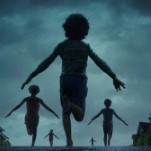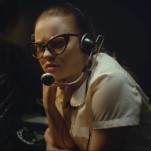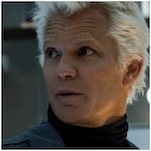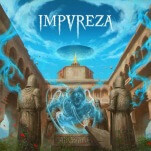Youth Wasted on the Old: Legacy and Ageism for Noah Baumbach and Olivier Assayas
In their latest films, Noah Baumbach and Olivier Assayas abnegate their artistic relevance to ravenous millennials.
Noah Baumbach’s While We’re Young kicks off with dialogue from The Master Builder, one of the most significant works of Norwegian playwright Henrik Ibsen. The text details an exchange between Halvard Solness, the architect of the play’s title, and Hilda, a young woman from Solness’s past who has arrived to assert herself in his present. He expresses to her his fear of the younger generation, who he believes will come to “thunder at [his] door,” while she rebukes his crotchety anxieties and recommends that he “open the door to the younger generation.” Solness responds to her advice with incredulity. “The younger generation,” he tells her, “it means retribution, you see. It comes, as if under a new banner, heralding the turn of fortune.”
If you’re familiar with Ibsen’s play (or if you caught Jonathan Demme’s 2014 film adaptation), then you know well enough that Solness’s words are eerily portentous. That’s exactly why Baumbach prefaces his own movie using Ibsen’s text, of course, and while it’s a bit on the nose, the quotes provide a clean summation of the conflict that develops between While We’re Young’s dueling married couples: gen-X’ers Josh (Ben Stiller) and Cornelia (Naomi Watts), and millennials Jamie (Adam Driver) and Darby (Amanda Seyfried). Josh and Cornelia are enamored of the lifestyle led by their twenty-something counterparts, who—per standard hipster taste—reject modernity for the retrograde (which they non-ironically fetishize via, among varied accoutrements, their cracked and busted iPhones), archaeologists (or vultures) learning about past lives by picking over graveyards littered with vinyl and VHS. Ultimately, Josh and Cornelia just can’t resist the allure of nostalgia: The two couples become friends; mid-life introspection ensues.
But The Master Builder captures such a broad perspective of generational dread that French auteur Olivier Assayas could have just as easily used it to preamble his latest picture, Clouds of Sils Maria. Here, Assayas examines the career of Maria Enders (Juliette Binoche), an internationally renowned actress whose career path has led her back to the beginning of her days as a star. She’s given an opportunity to appear in a contemporary production of the play that vaulted her to notoriety, a fictionalized piece called Maloja Snake, in which a middle-aged woman falls for her younger female protégé and winds up destroyed by her obsession. Once upon a time, Maria portrayed the latter, but in the present she’s asked to step into the older role, and she balks at the offer before eventually accepting.
There are two foils to Maria’s story of aging. The first is her assistant, Valentine (Kristen Stewart), who wields smart phones like fencing sabers and has a talent for turning aside her boss’s kvetching without ruffling feathers. The second is Jo-Ann Ellis (Chloë Grace Moretz), a Lohan-esque tabloid disaster whose classical thespian training remains invisible in the press courtesy of her much more widely publicized freak-outs and tantrums, each captured on camera and immortalized through YouTube. Jo-Ann is courted to play opposite Maria in Maloja Snake, much to Maria’s chagrin (and to Val’s intrigue). The resulting deconstruction of both art and artist is a whirling confrontation with personal and professional ennui.
At a glance, Clouds of Sils Maria and While We’re Young don’t bear much of a family resemblance. Maybe it’s the contrast between Clouds of Sils Maria’s European locales and While We’re Young’s Brooklyn backdrops; maybe it’s the refinement of the characters, relative from one movie to the other; maybe it’s that Clouds of Sils Maria looks like a much less outré version of the movie Birdman aspired to be, while While We’re Young is an expansion on Baumbach’s own Greenberg, and therefore the natural progression of his oeuvre. But as much as Baumbach’s film looks so different compared to Assayas’s, together they make for an unexpectedly cogent double feature, all thanks to Ibsen’s implied question: What happens when you open the door to the younger generation?
Both films seem to answer: They usurp your existence, taking everything of yours that’s bygone and making it frustratingly novel. In Clouds of Sils Maria, the threat of the young isn’t explicitly made to Maria herself, but to her personal outlook. Throughout the film, she and Valentine engage in repeated debates over their respective interpretations of Maloja Snake. Valentine, introspective, thoughtful and unpretentious, suggests that Maria approaches the play from the mindset of her 18-year-old self. “The text is like an object,” Valentine tells us. “It’s going to change perspective based on where you’re standing.” But Maria won’t budge. She’s stuck on her reading of the play, incapable of accepting any of the analyses Valentine proffers. The story is what Maria says it is; Valentine’s attempts to change her boss’s mind fall on adder’s ears. No wonder the veteran leading lady bristles at the thought of Jo-Ann taking over the part she made famous—like Valentine’s thoughts on the “stuff” of the material, having a young person replacing Maria on stage means putting her paradigm’s sanctity at risk.
-

-

-

-

-

-

-

-

-

-

-

-

-

-

-

-

-

-

-

-

-

-

-

-

-

-

-

-

-

-

-

-

-

-

-

-

-

-

-

-








































